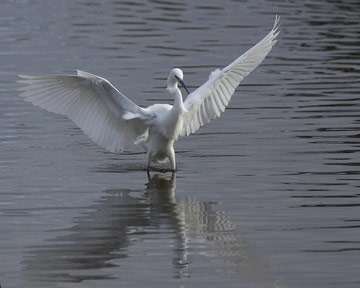
Little Egret © Richard Steel
The seasonal occurrence of Little Egrets has changed considerably in the short time that they have been regular members of the county’s avifauna. They have shifted from being overshooting spring birds to autumn post-breeding dispersers, then from 1997/98 onwards, birds have been seen throughout winter, mostly in the Dee estuary. The numbers have shot up during this decade, with peak counts, either feeding or at their night-time roost, in the six winters from 2001/ 02 to 2006/ 07 of 21 (November 2001), 30 (October 2002), 32 (November 2003), 70 (December 2004), 112 (October 2005) and 169 (same total on 8 September and 9 October 2006).
This Atlas map shows Little Egrets reported from 30 tetrads during the three winters of this survey, with a clear westerly bias and mostly on or near the estuaries. All of the submitted counts away from the Dee were of single birds apart from one flock of six feeding in creeks on Ince Marsh (SJ47P) in 2006/ 07. More than half of the recorded habitat codes (19 out of 36) were estuarine or saltmarsh, with four from reedbeds and a variety of freshwater habitats: 2 on small waterbodies; 3 on lakes/ reservoirs; and records from streams or ditches in the areas of Chester (SJ36Y), Hockenhull Platts (SJ46S/ X) and Fowle Brook next to Maw Green Tip (SJ75D). There is no reported change in their diet in winter.
The residence or migratory status of the birds in Cheshire and Wirral is not known. Apart from the single escaped bird from Chester Zoo, no ringed bird is known to have been reported in the county. Birds from continental Europe usually migrate south for winter, some staying around the Mediterranean but most crossing the Sahara. They cannot tolerate hard weather, and birds that wintered in France in the 1980s have died en masse in freezing conditions (Voisin 1991). However, this is an adaptable and responsive species and by the late 1990s the French wintering population numbered more than 20,000. It has been suggested that the higher numbers and northward penetration along the milder west coast of Britain than along the east is a reflection of their sensitivity to hard weather (Musgrove 2002).
Sponsored by Roy Eyres

